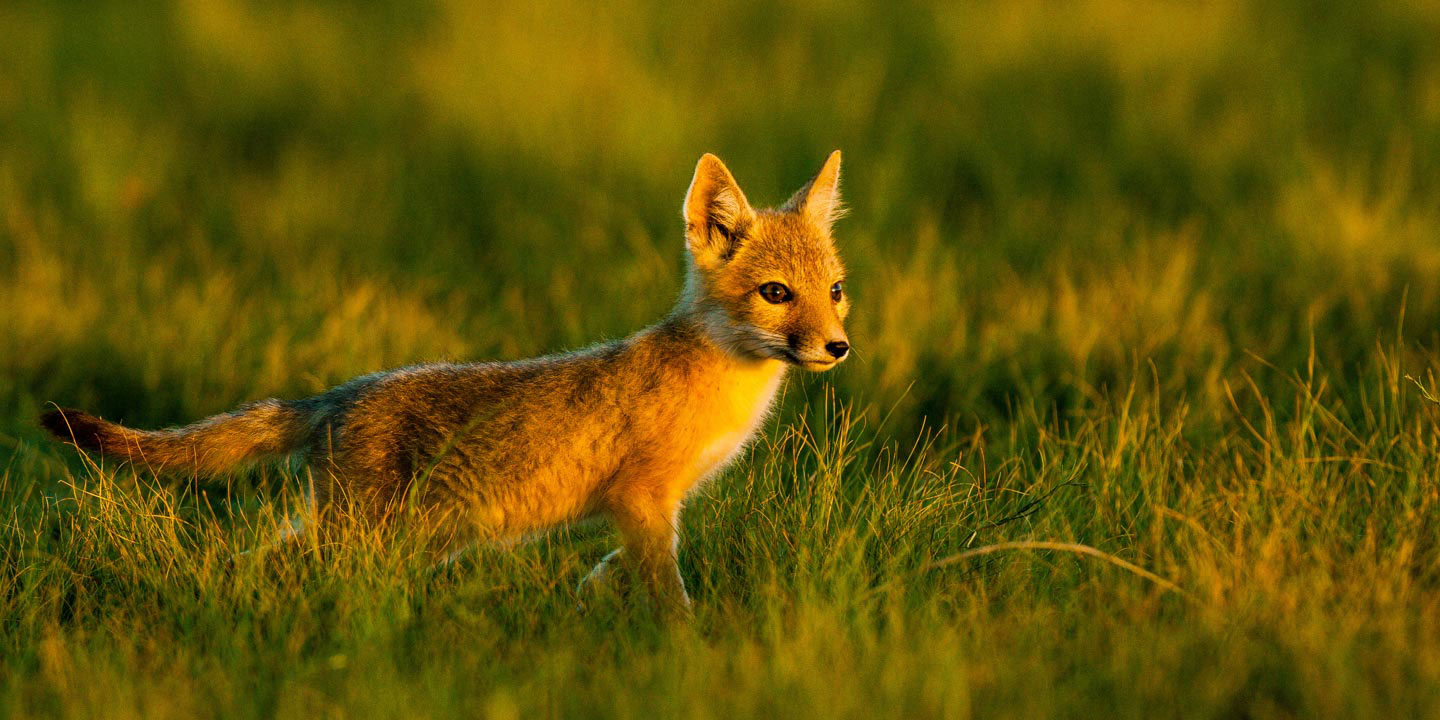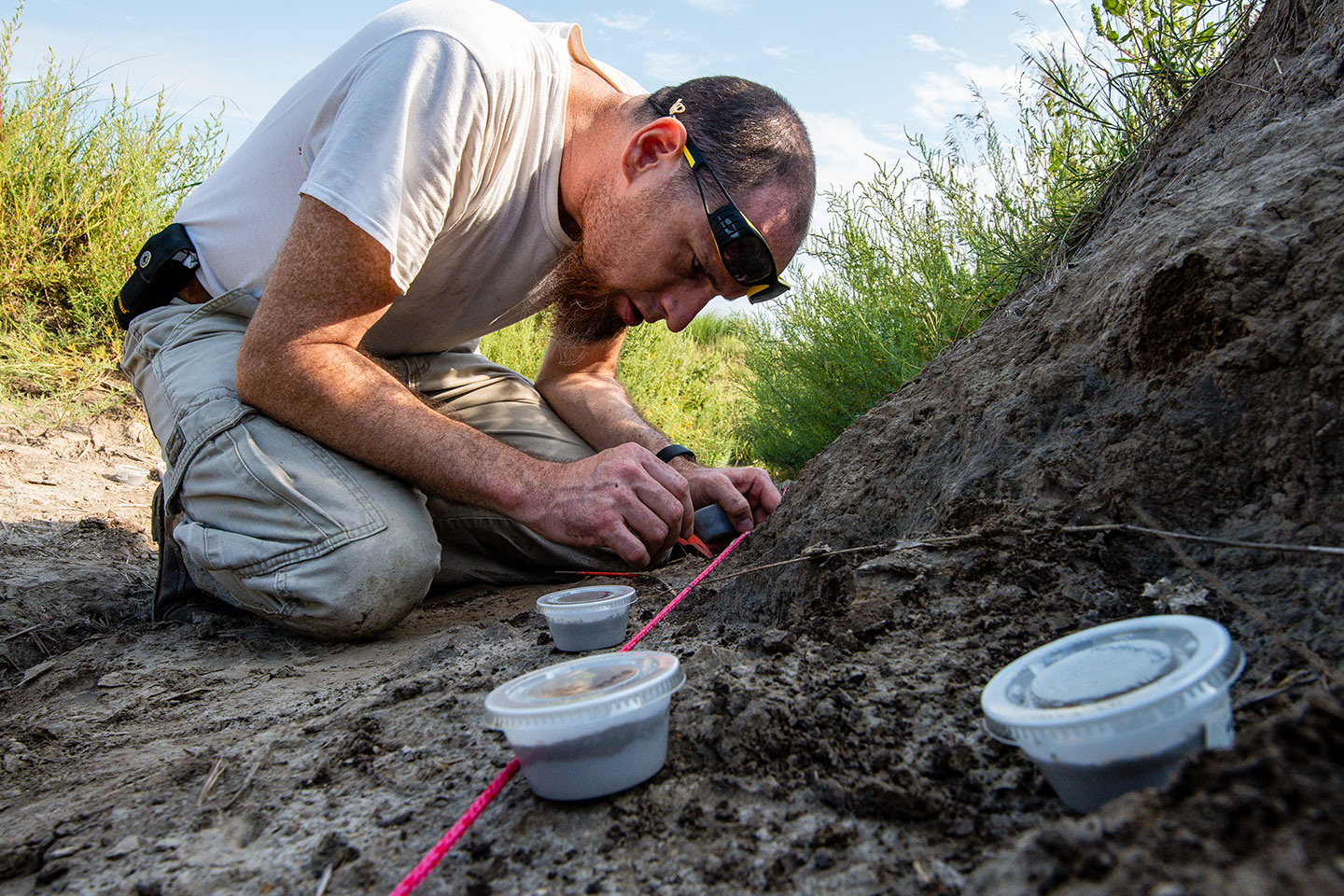Swift fox
Status: Endangered

The swift fox (Vulpes velox), the smallest wild canine living in North America, weighs 3-7 pounds. It reaches lengths of 27-32 inches from head to tail, and is about half the size of a red fox.
Its color varies with the seasons. In the winter, the swift fox is grayish-tan on the back and buff-orange underneath. In the summer, the back is more red-tan colored. It has a long, bushy tail with a black tip. The throat and chest are a cream color and black markings are visible on either side of the snout. The black patches on the nose help distinguish swift foxes from coyotes. The pale front chest and legs help distinguish them from red fox. The ears of the swift fox are unusually large, an adaptation which helps them better hear their prey and predators.
Swift foxes typically live 3-6 years, but have been known to live up to 14 years.
The name “velox” is Latin for “swift.” The swift fox is so named because it can reach speeds of up to 25 miles per hour.
Swift foxes are typically nocturnal hunters active from dusk to dawn. They can, however, be seen sunning themselves at the entrance to their burrow on sunny winter days and pups frequently play near the den during the day.
Range
The historical range of the swift fox includes the entire Great Plains region. It could be found from Alberta to Texas and from Minnesota and Iowa to New Mexico and Montana.
Today, the range of the swift fox is limited to the western edge of its historic range. It is estimated that swift foxes can be found in only 44 percent of their historic range. It is found in a few populations in south central Canada and the central and southwest United States. In Nebraska, the population exists only in the southwest corner of the state and the Panhandle.
Habitat
Swift foxes require open shortgrass prairies with few shrubs and trees. They often use Prairie Dog and Badger dens to raise their young. They can also dig their own dens, but this is rare. Swift foxes rely on the grasses remaining short through grazing, haying or fire to be able to scan for predators.
Other dog species such as the coyote and red fox use dens only during the breeding season. Swift foxes, on the other hand, use dens year-round. Swift foxes will often den in road ditches due to the fact that coyotes (a major predator of the swift fox) do not typically inhabit this area. In order to avoid predators and parasites (such as fleas), swift foxes will move to several different dens during the year.
Diet
The diet of the swift fox varies by season and includes any live, small prey it can catch. Although technically an omnivore, the majority of the swift fox’s diet is meat. The variety of prey eaten by the swift fox includes small mammals (prairie dogs and ground squirrels), birds, reptiles, amphibians, fish and insects. It will occasionally eat berries and grasses, and will feed on carrion (dead animals).
Reproduction
Swift foxes generally begin breeding when they are 1-2 years old. They typically form lifelong pairs although these pairs are not always monogamous. Breeding occurs in late winter from February through March and may continue to April or May in some areas. Gestation is approximately 50-55 days. The average litter size is four or five kits, but may be as few as two and as many as six. Both male and female parents help in the raising of the young.
Kits emerge from the dens in three or four weeks and are weaned in six or seven weeks. Young remain with the parents for four or five months during which time they learn to hunt. In early fall, the kits disperse to their own territory. Males often breed their first winter, but most females wait until the second winter to breed.
Population status
The major reason for the decline of the swift fox is habitat destruction and eradication efforts for predators. With the increase of agriculture in the Great Plains came a significant decrease in shortgrass prairie habitat. This, in turn, led to a decrease in prairie dog towns. With no prairie dogs, swift foxes lost a major prey species. Additionally, these prairie dog burrows provided a safe place for swift foxes to escape predators such as hawks, eagles, coyotes and humans.
Additionally, swift foxes may be killed by control methods aimed at coyotes such as poisoning and trapping. It should be noted, however, that because coyotes are a major predator of swift foxes, a reduction in coyote numbers can be beneficial to swift foxes.
Management and outlook
The swift fox is not a federally listed threatened or endangered species although consideration was given in the mid-1990’s to place it on the list. In Nebraska, it is on the state endangered species list.
Successful reintroductions have been completed in southern Canada and South Dakota, but no such reintroduction has been tried in Nebraska.
Because the swift fox needs wide open, short-grass areas, regular grazing and/or burning of shortgrass prairies will help allow for the swift fox population in Nebraska to grow. Manual removal of shrubs and trees will also help.
The Nebraska Game and Parks Commission conducts annual surveys for swift foxes.
Conservation help
New developments in the shortgrass prairie should take into account the habitat requirement of the swift fox. Additionally, maintaining a regimented grazing and/or burning regime on shortgrass prairies is critical especially where prairie dog communities do not exist.
All swift fox sightings should be reported to the Nebraska Game & Parks Commission at (402) 471-0641.
References
Panella, Melissa. Nebraska’s At-risk Wildlife. 2010. Nebraska Game and Parks Commission, Lincoln, NE.
Jones Jr., Knox. Mammals of the Northern Great Plains. 1983. University of Nebraska Press., Lincoln, NE.
Swift Fox Fact Sheet (online). 2012. U. S. Fish & Wildlife Service, North Dakota Field Office.
Resmer, K. Vulpes velox Species Profile (online). 1999. Animal Diversity Web, University of Michigan Museum of Zoology.
NOTE: New data of the occurrence and distribution of this species are being collected constantly and some of the information in the pamphlet may be outdated. The information in this pamphlet should be used for a general understanding of the species and not as the sole source of range location for any report, project, regional or local planning, or for environmental impact assessments. For current information on this species, please contact the Nebraska Game and Parks Commission, Wildlife Division.




